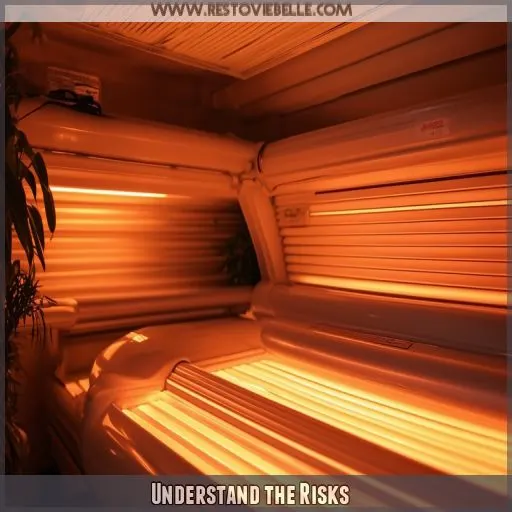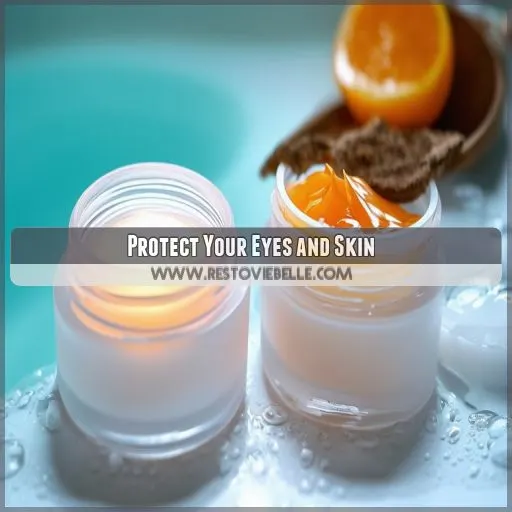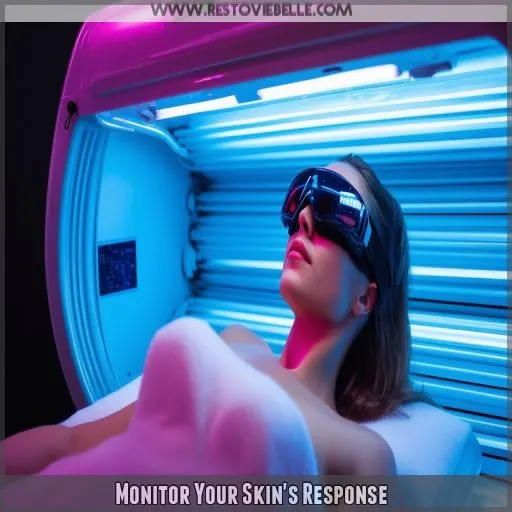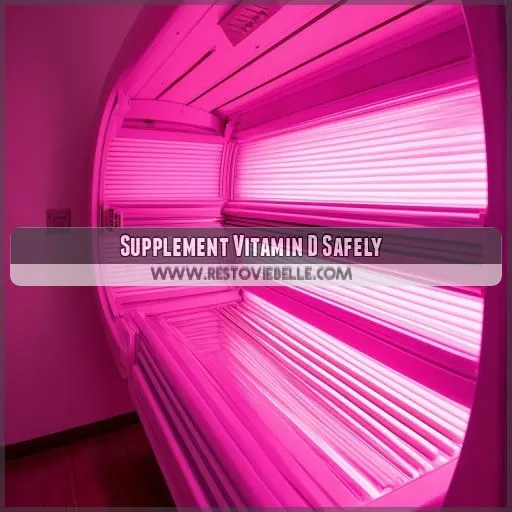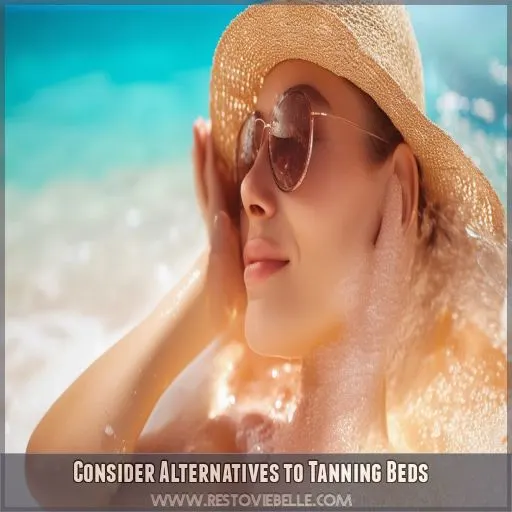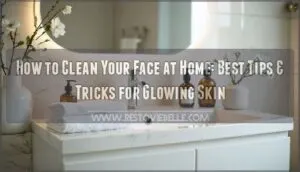This site is supported by our readers. We may earn a commission, at no cost to you, if you purchase through links.
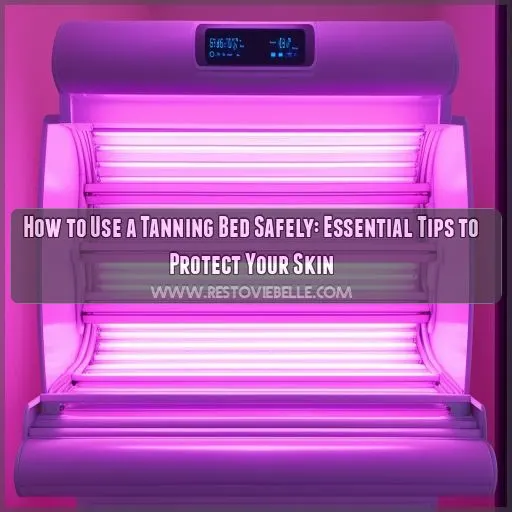
According to the World Health Organization, "tanning beds are carcinogenic to humans," and total use is not desirable. Instead, tanning bed users, even those who want a ‘base tan,’ should consider the risks and take steps to minimize the harm that using a tanning bed can cause.
Use a tanning bed properly—if you must use one—so that the least damage is done to the skin
Table Of Contents
- Key Takeaways
- How to Use a Tanning Bed Safely?
- Understand the Risks
- Start Slow and Gradually Increase
- Protect Your Eyes and Skin
- Monitor Your Skin’s Response
- Supplement Vitamin D Safely
- Consider Alternatives to Tanning Beds
- Frequently Asked Questions (FAQs)
- How to use a tanning bed safely for the first time?
- How do I protect my skin in a tanning bed?
- Is there a safe way to use sunbeds?
- How long should you tan in a tanning bed for beginners?
- Can you get a tan on a tanning bed?
- Would going to tanning bed help psoriasis?
- Are tanning beds safe?
- Should I use a shorter tanning bed?
- How often should I clean the tanning bed?
- Can I tan while pregnant or breastfeeding?
- What should I do if I feel dizzy after tanning?
- Are certain medications incompatible with tanning bed use?
- How long should I wait between tanning sessions?
- Conclusion
Key Takeaways
- Start slow and steady, like a turtle in a race against Father Time. Gradually build up your tanning time to avoid turning into a human lobster!
- Shield those peepers! Your eyes are precious gems, not UV ray catchers. Always wear protective goggles, unless you’re going for the "mole in sunglasses" look.
- Listen to your skin like it’s whispering secrets. If it’s screaming "ouch" or turning redder than a tomato, it’s time to pump the brakes on your bronzing adventure.
- Consider safer alternatives, because let’s face it, looking like an Oompa Loompa isn’t all it’s cracked up to be. Embrace the pale side or go faux with sunless tanning products – your future self will thank you!
How to Use a Tanning Bed Safely?
While it’s safest to avoid tanning beds altogether, if you choose to use one, there are steps to minimize risks.
To use a tanning bed safely, start with short sessions and gradually increase exposure time. Always wear protective eyewear and apply broad-spectrum sunscreen before and after tanning. Monitor your skin for any signs of redness or irritation, and stop immediately if you experience adverse reactions. Avoid the most intense settings and limit your overall tanning frequency.
Let’s explore more ways to protect your skin while achieving your desired look
Understand the Risks
Knowing the risks of tanning beds might be an excellent way to protect your skin. They may cause skin damage, wrinkling, suppression of one’s immune system, and dark rashes on sensitized skin; however, children and teens should never use these devices.
Skin Damage, Wrinkling, and immune system Suppression
Overexposure to the tanning bed can cause collagen breakdown and damage to elastin, which may further lead to premature aging, such as dark age spots and leathery skin.
There’s some evidence that there could also be increased risks for skin cancer. Besides, this practice has the potential to suppress your immune system.
That’s also important: it isn’t necessary to remember possible damage to your eyes.
Potential for Rashes in Sunlight-sensitive Individuals
Those sensitive to the sun may develop rashes when using a tanning bed. Ordinarily, UV radiation from UVA and UVB rays can irritate sensitive areas of the skin, causing redness characterized by very itchy patches.
If you see that your skin tends to be somewhat sensitive toward sunlight, then you have to be highly cautious and maybe just avoid a tanning bed in the first place. Do ensure that at all times while trying a new measure for safety, you keep an eye on what your skin is going to react to
Children and Teens Should Avoid Indoor Tanning
Children and teens should steer clear of indoor tanning due to its high risks. Age restrictions exist for a reason: developing bodies are more susceptible to UV damage. Parental consent can’t reduce these risks. Peer pressure and lax school policies shouldn’t override health education. Encourage healthy habits instead of tanning bed exposure. Prioritize health over harmful trends
Start Slow and Gradually Increase
When starting with a tanning bed, begin with short exposure times, like 5-10 minutes, to minimize the risk to your skin. Gradually increase the duration over several sessions, and always steer clear of the most intense settings to enhance safety
Begin With Short Exposure Times (e.g., 5-10 Minutes)
When using a tanning bed, start with short sessions of 5-10 minutes. This allows your skin to acclimate to the artificial ultraviolet rays gradually. Pay attention to your skin’s sensitivity and watch for any adverse reactions. Remember, there’s no rush to achieve a tan, and your safety should always come first.
- Your skin’s health is priceless – treat it with care!
- Slow and steady wins the race to a golden glow
- Listen to your body – it knows best
- Patience is key to avoiding a lobster-like fate
- Embrace the journey, not just the destination
Gradually Increase Exposure Time Over Multiple Sessions
As you begin tanning, slowly increase your exposure time during session-graduating over several sessions; this is an excellent way for your skin to acclimate as risks are decreased. Below is a sample tanning schedule:
| Week | Session Duration | Frequency | Precautions |
|---|---|---|---|
| 1 | 5-7 minutes | 2x | Sunblock |
| 2 | 7-9 minutes | 2x | Eye protection |
| 3 | 9-11 mins | 2x | Skin monitoring |
Avoid the Most Intense Tanning Bed Settings
As you build your tan, resist the urge to crank up the UV intensity. High-powered beds might seem like a shortcut, but they’re a fast track to skin damage.
Instead, stick to lower settings and gradually increase your tanning duration. Remember, there’s no such thing as a "safe base tan."
Your skin’s sensitivity doesn’t care about legislation – it cares about protection. Slow and steady wins the race against eye damage and liver issues
Protect Your Eyes and Skin
Always wear protective eyewear during tanning sessions to shield your eyes from harmful UV rays. Apply a broad-spectrum sunscreen to exposed skin before and after tanning to minimize damage and reduce your risk of sunburn
Always Wear Protective Eyewear During Tanning Sessions
As you work up your tanning time, remember to protect your eyes. The UV rays are dangerous to your peepers and are possibly causing eye damage, upping the cataract risks, and even putting you in danger of ocular melanoma.
Only use well-designed goggles for tanning that are protective and that fit well on the skin near and around the eyes for optimal protection against the rays—not your regular everyday sunglasses, which aren’t good enough for this purpose.
Standard eye protection contributes tremendously to preventing accelerated aging in the skin and a breakdown of collagen around the eyes, which is a susceptible area
Apply Broad-spectrum Sunscreen Before and After Tanning
While it might sound completely counterintuitive, the sunscreen you should apply after tanning is really a good broad-spectrum one.
Ultraviolet radiation isn’t picky, and tanning beds can even be stronger than natural sunlight.
Don’t skimp on sun protection—it’s your best defense against premature aging and skin damage
Monitor Your Skin’s Response
Pay close attention to your skin’s reaction after each tanning session, looking for any signs of redness, burning, or unusual sensitivity. If you notice any adverse effects or discomfort, stop using the tanning bed immediately and consult a healthcare professional for advice
Watch for Signs of Redness, Burning, or Sensitivity
- Redness or persisting patches that remain even after tanning
• Itching or burning sensation at the site during or after the session
- Unusual skin texture changes or sensitivity
Don’t ignore these signs in the pursuit of a "sun-kissed" glow. Sunburn prevention is key, and you need to remember your skin’s sensitivity. After all, tanning addiction just isn’t worth risking your health
Stop Tanning if You Experience Any Adverse Reactions
The reaction should be cut short by stopping tanning if you see any adverse effects. The health of the skin is more important than the need for sun-kissed skin. Look out for these common symptoms and what one should do as mentioned below:
| Warning Signs | Action to Be Taken |
|---|---|
| Excessive redness | Stop tanning for one week |
| Blisters | Seek medical advice |
| Itchiness | Moisturize. stay away from tanning |
| Odd-looking moles | Consult a dermatologist |
| Persistent dryness | Increase wetting, pause tanning |
Supplement Vitamin D Safely
But generally, it’s crucial to safely address increased vitamin D by monitoring your skin’s response to tanning. Many people will tell you that with more exposure to tanning beds, you increase the vitamin D levels in your body. Instead, try to find safer means by diet or supplementation.
The usual sources of vitamin D include fatty fish, egg yolks, and fortified dairy products. If you’re concerned about deficiency, it’s best to talk with your doctor about supplementation. They can advise on the proper dosage for your needs.
Keep in mind that a small amount of sun gives your skin a boost of vitamin D; it doesn’t call for hours of sunbathing. A few minutes outside daily, protected from the sun, will do.
You’ll protect your skin from unnecessary harm by prioritizing methods for vitamin D intake that are safer and, at the same time, modernizing health
Consider Alternatives to Tanning Beds
Consider safer alternatives to tanning beds, such as sunless tanning products like lotions, gels, or sprays that color your skin without UV exposure. You can also protect your skin by avoiding direct sunlight, wearing sun-protective clothing, seeking shade, and using sunscreen regularly to guard against sun damage
Sunless Tanning Products (lotions, Gels, Sprays)
If you’re looking for a safer alternative to tanning beds, consider sunless tanning products. These lotions, gels, and sprays can give you a sun-kissed glow without the risks associated with UV exposure.
The active ingredient, DHA, reacts with your skin’s proteins to create a tan-like appearance. When applying, follow the instructions carefully for even coverage
Sun Avoidance (wearing Sun-protective Clothing, Seeking Shade)
While sunless tanners offer a safer alternative, you can also protect your skin by avoiding sun exposure altogether. This doesn’t mean you can’t enjoy outdoor activities. Here are some effective strategies for sun avoidance:
- Wear protective clothing like wide-brimmed hats and long-sleeved shirts
- Seek shade, especially during peak sun hours (10 am to 4 pm)
- Use UV-blocking umbrellas or pop-up tents at the beach
- Choose sun-protective fabrics with a high UPF rating
Using Sunscreen to Protect Against Sun Damage
While sun avoidance is essential, you can’t always avoid UV rays. That’s where sunscreen steps in to help. It’s your skin’s best friend, even when in a tanning bed.
Choose a broad-spectrum sunscreen with a high SPF to give maximum protection against the sun. Note that tanning lotion doesn’t replace sunscreen.
Slather liberally before starting the tanning session and repeat afterward for maximum protection
Frequently Asked Questions (FAQs)
How to use a tanning bed safely for the first time?
While there’s no truly safe way to use tanning beds, if you’re determined, start slow. Wear protective eyewear, limit your time to 5-7 minutes, and don’t exceed once a week. Remember, any tan is skin damage
How do I protect my skin in a tanning bed?
You can’t fully protect your skin in a tanning bed. Wear goggles, use recommended exposure times, and start slowly. But remember, there’s no safe tan. Consider sunless tanning alternatives to avoid damaging your skin
Is there a safe way to use sunbeds?
There’s no truly safe way to use sunbeds. They emit harmful UV rays that increase your risk of skin cancer and premature aging. It’s best to avoid them entirely and opt for safer alternatives like self-tanning lotions
How long should you tan in a tanning bed for beginners?
Picture your skin as delicate silk. For beginners, start with just 2-3 minutes. You’ll gradually increase by 1-2 minutes per session, never exceeding the manufacturer’s recommended time. Always wear protective eyewear and listen to your skin’s signals
Can you get a tan on a tanning bed?
Yes, you’re able to receive a tan from a tanning bed. However, the important thing to remember is that any tan is a sign of skin damage. You are, in essence, exposing yourself to harmful UV rays which are directly connected to an elevated risk of causing skin cancer.
Would going to tanning bed help psoriasis?
Are you caught between a rock and a hard place with psoriasis? While tanning beds might seem tempting, they’re not recommended. UV exposure can worsen symptoms and increase skin cancer risk. It’s best to consult your doctor for safer treatment options
Are tanning beds safe?
Tanning beds aren’t safe. They increase your risk of skin cancer, premature aging, and eye damage. The UV rays are stronger than sunlight, and there’s no such thing as a "safe tan." Consider sunless tanning options instead
Should I use a shorter tanning bed?
Shorter tanning beds don’t make indoor tanning safer. They still emit harmful UV rays that damage your skin and increase cancer risk. Instead, consider sunless tanning options like lotions or sprays for a safer, healthier glow
How often should I clean the tanning bed?
Time to shine a light on cleanliness! You should clean the tanning bed after every use. Wipe down all surfaces with an approved disinfectant, paying special attention to high-touch areas. Don’t forget to clean the acrylic shield thoroughly
Can I tan while pregnant or breastfeeding?
You shouldn’t tan while pregnant or breastfeeding. UV exposure can harm your baby’s development and increase your risk of skin damage. Instead, try safe alternatives like self-tanning lotions if you’re looking for a sun-kissed glow
What should I do if I feel dizzy after tanning?
If this happens and you feel dizzy after tanning, you have to act quickly: get straight out of the unit, sit gently down, and have a drink of water. Seek medical advice if it persists. That could be indicative of overexposure or dehydration.
Are certain medications incompatible with tanning bed use?
That is a good reason to be careful. Many medications can make your skin more sensitive to the sun. Always check with your doctor before tanning. Certain antibiotics, acne treatments, and other drugs can cause severe reactions
How long should I wait between tanning sessions?
Ye olde tanning enthusiast, wait at least 24-48 hours between sessions. Your skin needs time to recover and produce melanin. Don’t overdo it; frequent tanning increases skin damage and cancer risks. Listen to your body and prioritize safety
Conclusion
As the sun-worshipping warmth lures you in, remember to learn how to use a tanning bed safely. Go slow and see how your body responds while being sure to protect your skin and your eyes.
Healthier alternatives are out there, such as sunless tanning products or the idea of embracing your natural skin color.
Should you decide to use a tanning bed, consider these ideas to help minimize the risks. Your health should come first.
Stay informed, make wise choices, and give your skin a reason to be happy and healthy for years to come

